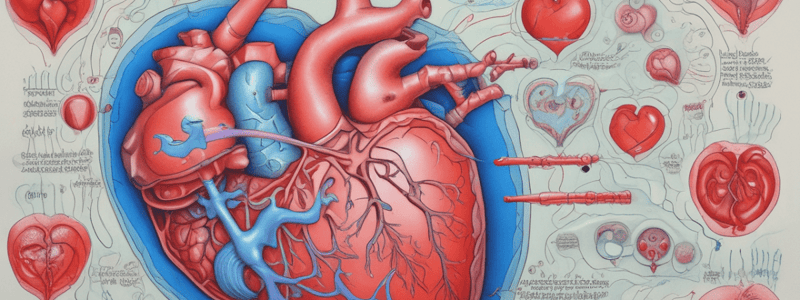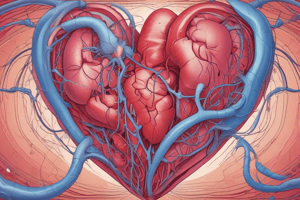Podcast
Questions and Answers
What is the function of the ductus venosus in fetal circulation?
What is the function of the ductus venosus in fetal circulation?
- Closes after birth due to flow reversal as SVR increases
- Allows oxygenated blood from placenta to pass from RA to LA
- Bypasses liver and enters IVC with oxygenated placental blood (correct)
- Deoxygenated blood from SVC passes into RV and is pumped into PA
What is the result of increased SVR in the transition from fetal to neonatal circulation?
What is the result of increased SVR in the transition from fetal to neonatal circulation?
- Flow reversal in foramen ovale (correct)
- Decreased PVR
- Expansion of lungs
- Closure of ductus arteriosus
What is the most common form of congenital disease?
What is the most common form of congenital disease?
- Trisomy 21
- Multifactorial origin
- Chromosomal abnormalities
- Congenital heart disease (correct)
What is the percentage of congenital heart disease associated with chromosomal abnormalities?
What is the percentage of congenital heart disease associated with chromosomal abnormalities?
What is the purpose of prophylaxis in patients with certain cardiac conditions?
What is the purpose of prophylaxis in patients with certain cardiac conditions?
What is the result of a left-to-right shunt in acyanotic disease?
What is the result of a left-to-right shunt in acyanotic disease?
What is the threshold for closure of an atrial septal defect?
What is the threshold for closure of an atrial septal defect?
What is the consequence of a large atrial septal defect?
What is the consequence of a large atrial septal defect?
What is the incidence of ventricular septal defect in congenital heart disease?
What is the incidence of ventricular septal defect in congenital heart disease?
What is the primary goal of the Mustard or Senning procedure in older adults with transposition of the great arteries?
What is the primary goal of the Mustard or Senning procedure in older adults with transposition of the great arteries?
Why is the onset of inhaled drugs delayed in patients with transposition of the great arteries?
Why is the onset of inhaled drugs delayed in patients with transposition of the great arteries?
What is the primary concern in anesthetic management of a patient with a large ventricular septal defect?
What is the primary concern in anesthetic management of a patient with a large ventricular septal defect?
What is the main reason for the low survival rate in patients with truncus arteriosus?
What is the main reason for the low survival rate in patients with truncus arteriosus?
What is the primary treatment goal for patients with hypoplastic left heart syndrome?
What is the primary treatment goal for patients with hypoplastic left heart syndrome?
A patient with a patent ductus arteriosus is scheduled for surgical correction. What is the primary goal of anesthetic management?
A patient with a patent ductus arteriosus is scheduled for surgical correction. What is the primary goal of anesthetic management?
What is the primary complication of double aortic arch?
What is the primary complication of double aortic arch?
A patient with tetralogy of Fallot is experiencing a hypercyanotic attack. What is the most appropriate treatment?
A patient with tetralogy of Fallot is experiencing a hypercyanotic attack. What is the most appropriate treatment?
What is the primary concern in patients with a right-to-left shunt?
What is the primary concern in patients with a right-to-left shunt?
What is the primary goal of anesthetic management in patients with pulmonic stenosis?
What is the primary goal of anesthetic management in patients with pulmonic stenosis?
What is the primary effect of increasing systemic vascular resistance in patients with a right-to-left shunt?
What is the primary effect of increasing systemic vascular resistance in patients with a right-to-left shunt?
A patient with tetralogy of Fallot is undergoing surgical correction. What is the primary concern in anesthetic management during induction?
A patient with tetralogy of Fallot is undergoing surgical correction. What is the primary concern in anesthetic management during induction?
What anesthetic management is recommended for a patient with Tetralogy of Fallot?
What anesthetic management is recommended for a patient with Tetralogy of Fallot?
What is the primary effect of positive pressure ventilation in patients with a right-to-left shunt?
What is the primary effect of positive pressure ventilation in patients with a right-to-left shunt?
What is the necessary condition for survival in a patient with Tricuspid Atresia?
What is the necessary condition for survival in a patient with Tricuspid Atresia?
What is the primary anatomical feature of Transposition of the Great Arteries (D-Transposition)?
What is the primary anatomical feature of Transposition of the Great Arteries (D-Transposition)?
What is the initial treatment goal for a patient with Transposition of the Great Arteries?
What is the initial treatment goal for a patient with Transposition of the Great Arteries?
What is the mortality rate without surgical treatment for a patient with Transposition of the Great Arteries?
What is the mortality rate without surgical treatment for a patient with Transposition of the Great Arteries?
Flashcards are hidden until you start studying
Study Notes
Congenital Heart Defects
- Incidence: 7-10 per 1000 live births
- Chromosomal abnormalities: 10% of cases
- Multifactorial origin: 90% of cases (genetic and external factors)
Shunting vs. Obstructive vs. "Other" Lesions
- Shunting:
- ASD (Atrial Septal Defect)
- VSD (Ventricular Septal Defect)
- PDA (Patent Ductus Arteriosus)
- Obstructive:
- Aortic Stenosis
- Pulmonic Stenosis
- Coarctation of the Aorta
- "Other":
- Tetralogy of Fallot (TOF)
- Tricuspid Atresia
- Transposition of the Great Arteries
- Truncus Arteriosus
- Hypoplastic Left Heart
- Double Aortic Arch
Atrial Septal Defect (ASD)
- Small lesions may remain asymptomatic throughout life
- Symptoms of a large ASD:
- Supraventricular dysrhythmias
- Right heart failure
- Paradoxical air embolus
- Recurrent pulmonary infection
- Procedure: Percutaneous or open
Ventricular Septal Defect (VSD)
- Most common congenital heart defect
- Often closes spontaneously in infancy
- Percutaneous or open procedure
Patent Ductus Arteriosus (PDA)
- Failure of spontaneous closure
- Function of ductus arteriosus in fetus:
- Allows PA blood to bypass lungs and travel to placenta via aorta
- Symptoms:
- Pulmonary hypertension
- Heart failure
- Medical treatment: Non-selective inhibition of prostaglandin synthesis (Indomethacin, Ibuprofen)
Aortic Stenosis
- Bicuspid aortic valve in 2-3% of population
- Often associated with other CV abnormalities
- Symptoms:
- Angina
- Syncope
- Heart failure
Pulmonic Stenosis
- Symptoms:
- Dyspnea on exertion
- Peripheral edema
- Ascites
- Cyanosis (if foramen ovale is patent)
- Management:
- Avoid decreases in systemic blood pressure
- Maintain sinus rhythm
- No changes in PVR typically a problem
Coarctation of the Aorta
- Anatomic location:
- Preductal (just proximal to ductus arteriosus)
- Postductal (most common, just distal to ductus arteriosus)
- Signs and symptoms:
- BP difference between upper and lower body
- Hypertension
- CHF
- Aortic dissection
- Treatment:
- Resection or balloon dilation and stenting when pressure gradient reaches 30 mmHg
Cyanotic Lesions
- Results in:
- Decreased pulmonary blood flow
- Arterial hypoxemia
- Risks:
- Thromboembolism
- Brain abscess
- Survival very limited without surgical correction
Tetralogy of Fallot (TOF)
- Most common cyanotic congenital lesion
- Components:
- Large, single VSD
- Overriding aorta
- Right ventricular outflow obstruction
- Right ventricular hypertrophy
- Pathophysiology:
- Large VSD results in equalization of left and right ventricular pressures, resulting in RVH
- Right-to-Left shunting occurs due to VSD, RVH, and obstruction to the right ventricular outflow tract (PA)
- Resulting decrease in pulmonary blood flow produces arterial hypoxemia
- Signs and symptoms:
- Systolic ejection murmur
- Cyanosis
- Increased hemoglobin and hematocrit
- Squatting
- Hypercyanotic attacks
- CVA
- Cerebral abscess
- Infective endocarditis
Anesthetic Management of TOF
- Preoperatively:
- Maintain hydration
- Continue beta-blockers
- Avoid precipitation of a hypercyanotic attack
- Induction:
- Avoid reductions in SVR
- IV induction may be more rapid, dosages may need to be reduced
- Ketamine preferred choice
- Maintenance:
- Ketamine + nitrous oxide maintains SVR
-
- Volatile anesthetics
-
- Gently titrated opioid or benzodiazepine
- Muscle relaxant – Avoid histamine release
- Ventilation – Avoid high inspiratory pressures and PEEP
- Avoid air embolism
- Hemodynamic management:
- Beta-blockers
- Phenylephrine
Studying That Suits You
Use AI to generate personalized quizzes and flashcards to suit your learning preferences.




